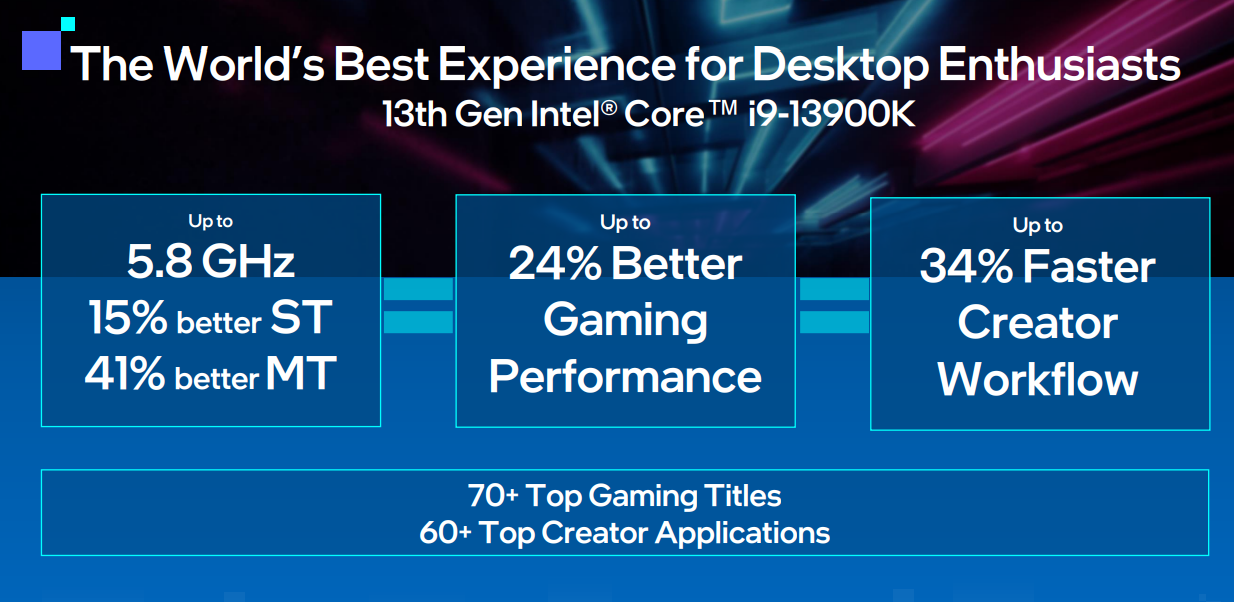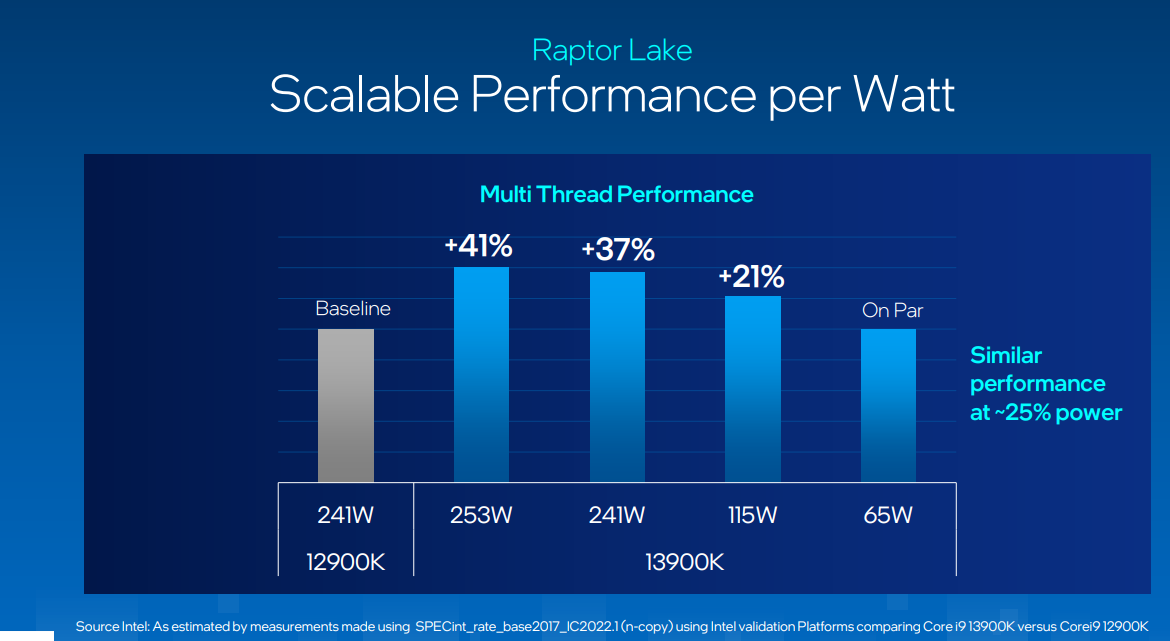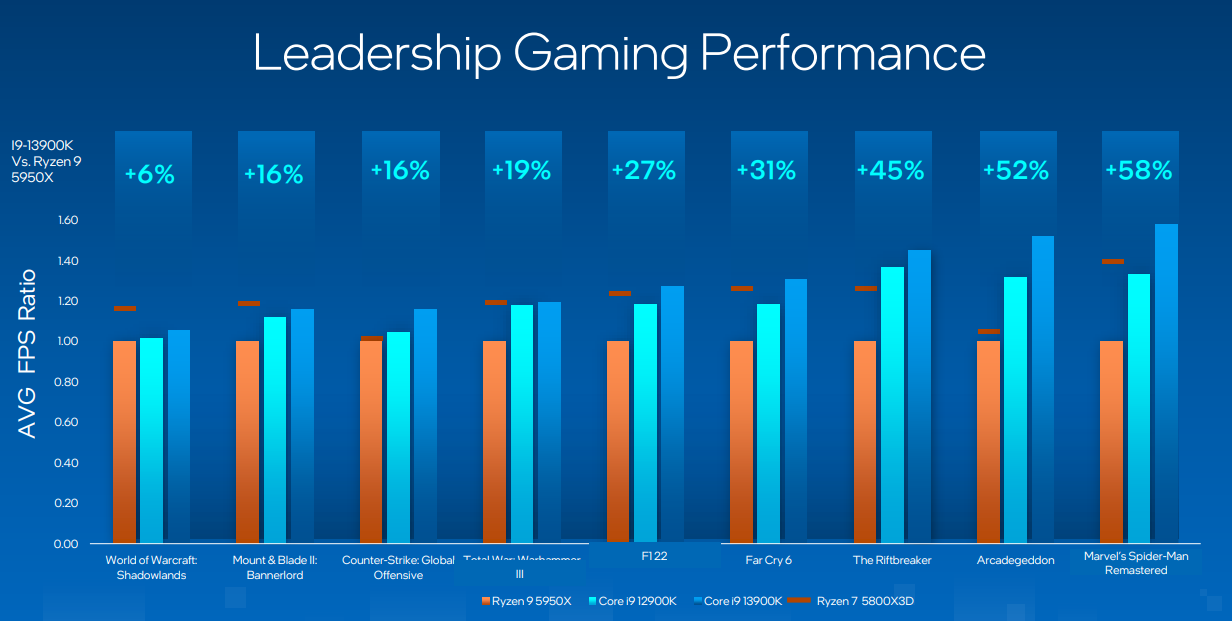All prices in USD.
Intel’s 12th-gen “Alder Lake” processors were widely considered to be the turning point for Intel after it ceded ground for years to AMD. Now, the company’s 13th gen “Raptor Lake” processor has landed with a continued focus on the hybrid architecture.

The Intel 13th gen Raptor Lake processors build upon the dual microarchitecture design first introduced in Alder Lake, Intel’s 12th-generation processors. By distributing workloads between performance cores (P-cores) and efficiency cores (E-cores), the design frees Intel of the burden of scaling one core architecture for both intensive and background tasks.
Intel 13th gen “Raptor Lake” processor specifications
| Processor | Cores | Threads | Cache (L2+L3) | P-core frequency (turbo/base) | E-core frequency (turbo/base) | CPU PCIe 5 lanes |
| Core i9-13900K | 24 (8+16) | 32 | 36MB+32MB | 5.8GHz/3GHz | 4.3GHz/2.2GHz | 20 |
| Core i9-13900KF | 24 (8+16) | 32 | 36MB+32MB | 5.8GHz/3GHz | 4.3GHz/2.2GHz | 20 |
| Core i7-13700K | 16 (8+8) | 24 | 30MB+24MB | 5.4GHz/3.4GHz | 4.2GHz/2.5GHz | 20 |
| Core i7-13700KF | 16 (8+8) | 24 | 30MB+24MB | 5.4GHz/3.4GHz | 4.2GHz/2.5GHz | 20 |
| Core i5-13600K | 14 (6+8) | 20 | 24MB+20MB | 5.1GHz/3.5GHz | 3.5GHz/2.6GHz | 20 |
| Core i5-13600KF | 14 (6+8) | 20 | 24MB+20MB | 5.1GHz/3.5GHz | 3.5GHz/2.6GHz | 20 |
Specs, continued
| Processor | Graphics | Memory | Max memory | Base / Turbo power | Price |
| Core i9-13900K | Intel HD 770 | DDR5 5600
DDR4 3200 |
128GB | 125W/253W | US$589 |
| Core i9-13900KF | N/A | DDR5 5600
DDR4 3200 |
128GB | 125W/253W | US$564 |
| Core i7-13700K | Intel HD 770 | DDR5 5600
DDR4 3200 |
128GB | 125W/253W | US$409 |
| Core i7-13700KF | N/A | DDR5 5600
DDR4 3200 |
128GB | 125W/253W | US$384 |
| Core i5-13600K | Intel HD 770 | DDR5 5600
DDR4 3200 |
128GB | 125W/181W | US$319 |
| Core i5-13600KF | N/A | DDR5 5600
DDR4 3200 |
128GB | 125W/181W | US$294 |
Whereas Alder Lake set the course for Intel’s near-term processor designs, Raptor Lake optimized it. Intel had improved upon Alder Lake’s “Golden Cove” and “Gracemont” microarchitectures with Intel 7, Intel’s third generation 10nm “SuperFin” process, relying heavily on the efficiency gains of the refined node. Describing the efficiency in broad strokes, Intel said that Raptor Lake offers similar performance to Alder Lake at half or even a quarter of the power.

The most impactful upgrade is in the core count. All SKUs from the performance to the midrange now carry more cores and have increased clock speeds.
At the top of the stack is the Core i9-13900K/KF. With 24 cores split between eight performance cores (P-cores) and 16 efficiency cores (E-cores), they have eight more E-cores than the Core i9-12900K. Because the “Gracemont” E-cores do not support hyperthreading, the Core i9-13900K carries a total of 32 threads. Intel said that the Core i9-13900K can reach 5.8GHz out of the box, a 600MHz increase over the Core i9-12900K despite having double the number of E-cores.
Moving down the stack, the Core i7-13700KF also got four more E-cores, bumping its core count to 16. At 5.4GHz, its P-core peak frequency is 400MHz higher than the Core i7-12700K. The Core i5-2600K/KF follow the same trend: four more E-cores and a higher clock speed.
Intel’s performance claims
Intel says that Raptor lake delivers 15 per cent better single-thread performance and 41 per cent higher multithreaded performance. In single-threaded workloads, the frequency boost accounts for most of the performance increase, aided by an enhanced cache architecture and memory improvements. The additional E-cores played the biggest part in increasing multithreaded performance, as expected.

What this means is a 58 per cent uptick in gaming performance over the AMD Ryzen 9 5950X, Intel claimed. On the gaming performance graph below, using a subtle red line, Intel also indicated the performance of the Ryzen 7 5800X3D, a gaming-oriented AMD processor that featured a high clock speed and a whopping 96MB of 3D V-Cache. Against it, the Core i9-13900K appears to trade blows.

Intel also claims that the Core i9-13900Kleads in creative workloads by demonstrating that the chip holds up to a 69 per cent lead over the Ryzen 9 5950X.

To achieve this, Intel not only had to rely on its new process but also had to do some tweaking to the microarchitecture.
Prefetching, the function to predictively load information into cache memory before it’s needed, has been polished on both the P-cores and E-cores. Intel says that by using machine learning and real-time telemetry data, prefetch can dynamically adjust based on the workload type. The company claims that the new system increases performance by four per cent in applications like the Adobe suite. And although the E-core’s architecture remained the same gen-on-gen, the prefetch improvement increases its multithreaded performance by seven per cent.
The ring, or the on-die interconnect, is now also “dramatically faster” at 5GHz—900MHz higher during all core turbo than Alder Lake. Intel says the lowers latency path to memory is “critical” to game performance and brings around five per cent frame rates on average.

Lastly, Raptor Lake features a tweaked Thread Director that can better classify threads. It can also better distinguish between user-initiated and background tasks. This new feature apparently requires the Windows 11 H2 update that was released last week.
Increased power limits
Increasing clock speeds and core count naturally increases power consumption, but it didn’t seem to impact the enthusiast range all that much. Although the Core i9-13900K has more cores and a higher boost frequency, its turbo power limit only increased by 10W over the Core i9-12900K, now demanding 253W compared to 241W. To keep it cool, air cooling is totally out of the question; a large all-in-one liquid cooler is practically mandatory.
The performance Core i7 segment, however, is a different story. The Core i7-13700K now also limits turbo power at 253W, which is 63W higher than the Core i7-12700K. That extra power feeds the four additional E-cores, and helps to raise the turbo frequency on both the E-core and P-core from 5.0GHz/3.8GHz on the previous generation to 5.4GHz/4.2GHz. This should be at least a bit concerning as it may demand a much more capable cooler than the previous generation.
The Core i5s asks for more power too, albeit less than the Core i7 series. The Core i5-13600K has a max turbo power of 181W, a 31W increase over the Core i5-12600K. Its turbo frequencies (P-Core/E-core) have been set at 5.1GHz/3.9GHz. For comparison, the Core i5-12600K featured a P-Core/E-core frequency of 4.9GHz/3.6GHz.
Chipset and platform enhancements
A new chip means a new chipset. Raptor Lake will be paired with the Z700 motherboards, but they aren’t a mandatory buy for owners of a Z600 motherboard.
Raptor Lake continues to use the same LGA1700 socket as Alder Lake and is backward compatible with Z600 motherboards. This means that users won’t need to purchase new motherboards and memory if they’re looking to upgrade from the previous generation. However, they may need to invest in a better cooler if they’re jumping between tiers or grabbing the new i7s.
The Z700 chipset brings eight additional PCIe Gen 4.0 lanes for a maximum of 20. In addition, it also supports eight PCIe gen 3.0 lanes for a total of 28 lanes off of the motherboard. Communication between the motherboard and chipset is delivered over DMI 4.0, which was introduced in the last generation.
DDR5 memory now plays better with Intel’s processors. Not only does Raptor Lake’s DDR5 memory spec has been raised to 5600MHz (800MHz higher than Alder Lake), but Intel also promises that its extreme memory profiles (XMP) can now hit 6,600MHz and beyond frequencies. As with Alder Lake, the Z700 series platforms will continue to support both DDR4 and DDR5 memory.
In addition to memory enhancements, the Raptor Lake platform will also bring nifty features like Wi-Fi sensing, and Bluetooth LE audio.
Cost
Good news: all Raptor Lake processors announced thus far have the same MSRP as the previous generation. At these prices, Intel is seriously dialling up the value proposition against AMD’s recently announced Ryzen 7000 series processors, especially now that they have even more cores than before.
Comparing the launch prices, the Core i9-13900K sits between the 16-core Ryzen 9 7950X and the 12-core Ryzen 9 7900X, undercutting the former by $110, and is $40 more than the latter. Doing some finger math, $40 comes to around 7 per cent of $549 (the retail price of the Ryzen 9 7900X). If the Core i9-13900K can beat the Ryzen 9 7900X by just 7 per cent in both single and multithreaded applications, then it’s easily the better buy. Although AMD extolled the benefits of its Zen 4 microarchitecture, we’re still expecting the Core i9-13900K to be competitive against the more expensive Ryzen 9 7950X.
Still, the fact that the Ryzen chips only have fully-fledged performance cores can’t be ignored. The Ryzen 9 7950X has 16 of them, while the Ryzen 9 7900X has 12. In contrast, the Core i9-13900K has just eight P-cores. In workloads that use fewer than 16 cores, the Ryzen chips could still come out on top.
The Core i7-13700K and Core i7-13700KF hover around the $399 MSRP of the 8-core Ryzen 7 7700X. Again, looking at the spec sheet alone, the AMD chip may find it difficult to keep pace in multithreaded workloads, given the gap in core count.
Similarly, the Core i5-13600K and Core i5-13600KF prices flank that of the $299 Ryzen 5 7600X. Like the i7s, they match the AMD chip core-for-core in P-cores but also have eight E-cores. It once again implies higher multithreaded performance.
With that said, AMD’s Ryzen 7000 processors do appear to have lower thermal design power. The Ryzen 5 7600X also has a higher boost frequency than the Core i5-13600K, which could help its performance.
Raptor Lake and the Intel Z790 chipset will be available starting Oct. 20, 2022.
